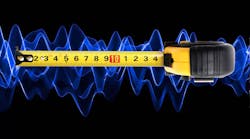The Mystery of Measuring Microwave and Millimeter-Wave Frequencies
How do you measure microwave and millimeter wave frequencies precisely? As with most electronic technologies, frequency is an important parameter, but in any wireless application you must know your frequency with dead-on precision in order to comply with the spectrum regulations you are operating under.
But that’s not all: You also occasionally need to pin down sources of interference so you can avoid or eliminate them. In applications like electronic warfare (EW), you absolutely have to know the frequency of a radar, jamming, or communications signal frequency, and you need to know it immediately so action can be taken. So just what is the process of measuring frequency at these elevated levels at that speed?
The most obvious frequency measurement method is to use a commercial bench frequency counter. Multiple vendors have these, and you can measure frequencies out to about 60 GHz in most cases. These counters simply open a gate for a precise interval and count the pulses that occur. The frequency is the ratio of the number of pulses counted to the gate time.
For example, if you count 60K pulses in one microsecond, the frequency is 60 GHz. This is then translated into a frequency display. For the very high frequencies, the counter may use a pre-scaler or downconverter/mixer to translate the high input frequency signal down to an IF within the range of the counter.
You can also measure frequency on a spectrum analyzer. Its horizontal scale is calibrated so a reasonable measurement can be made. Such measurements are useful for finding harmonics, intermodulation distortion products, and interfering signals, but the precision just isn’t there.
Another method is to digitize the signal and run its signal through a discrete Fourier or fast Fourier transform and decompose it into the signal fundamental and harmonic components. This may work for some applications, but high-speed ADCs and a DSP are needed. Some test instruments use this technique.
For engineering design and production testing, counters may be adequate. But in other cases, these methods are just too slow and the equipment inappropriate. One approach if you need an embedded solution is to implement the interval count method with a high-speed FPGA. Then again, for some EW applications, even that may not be fast enough. Luckily, some other methods for frequency measurement have been developed.
In EW applications like radar, jamming, and communications, frequency needs to be measured as fast and as precisely as possible. One good technique is called instantaneous frequency measurement (IFM). Special IFM receivers are used in all forms of EW equipment.
IFM receivers use analog frequency discriminators (AFD) or digital frequency discriminators (DFD) to measure signals fast. An AFD uses the interferometer method to measure frequency. The signal is divided into two equal parts: One signal is passed through a fixed reference delay line and the other is sent through another delay line. The delay lines are phase shifters whose time delays are related to the signal frequency. The phase shifters are usually microstrip lines.
The phase shifter outputs are compared and the phase difference between them is a measure of the frequency. A Schottky diode translates this difference signal to DC for measurement. In practice the signal is divided and passed through a group of delay lines. The longest line defines the AFD resolution while the shorter lines determine the actual frequency. A DFD uses a similar approach but digitizes the AFD outputs to get a binary output.
A version of the IFM receiver is a reconfigurable frequency measurement (RFM) receiver. It uses the IFM interferometer method where the input power divider splits the signal between a fixed reference delay and a switchable bank of delay lines. The multiple delay lines and fast switching circuits make the RFM frequency agile, but somewhat slower than an IFM receiver. The output signal is detected and digitized.
The whole interferometer technique is about the only measurement technique fast enough to be effective in EW applications. It is a very interesting method derived from optical measurements. But if you want to know more, a new book from Artech House has the details. Titled Frequency Measurement Technology, the book goes into great detail about the various methods with math elucidation. The text has very clear descriptions of the circuits and techniques. Click here to get a copy.

